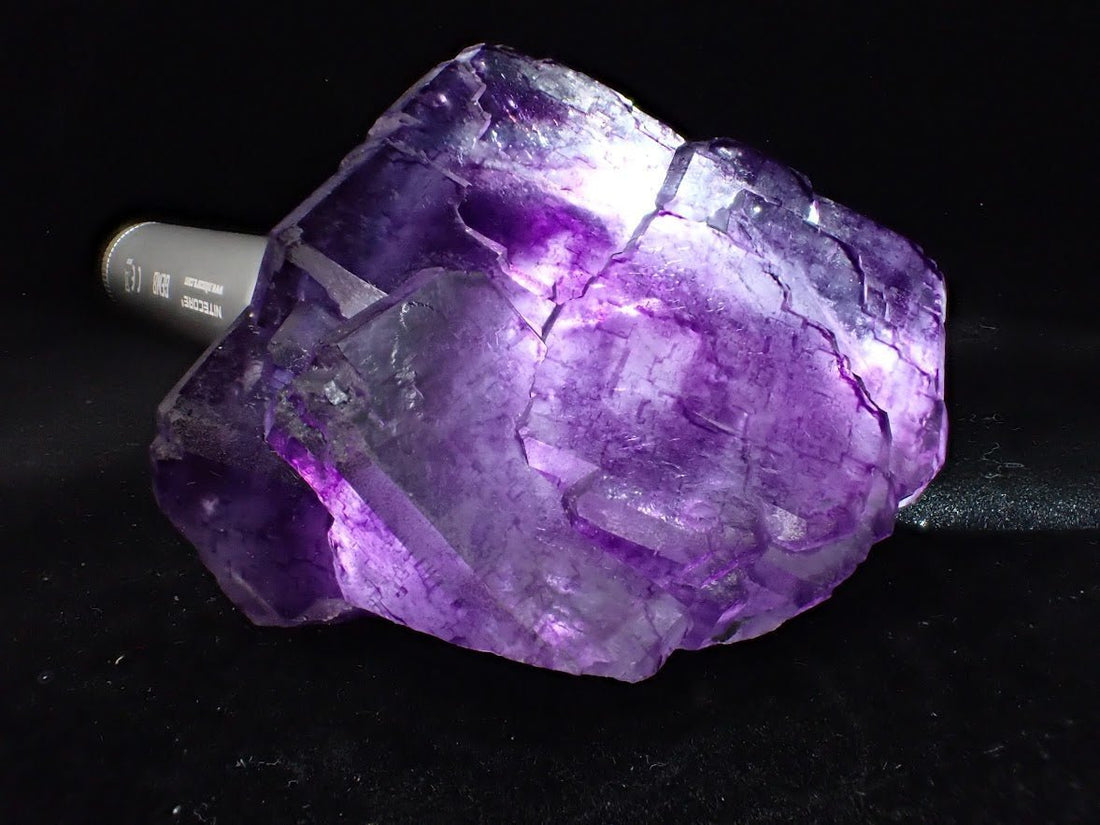
How the Colors of Fluorite Are Created
Share
From deep purple cubes to glowing green clusters and pastel rainbows, fluorite is one of the most colorful and chemically intriguing minerals on Earth. But what causes all those stunning hues? The answer lies in the crystal’s chemistry — and the imperfections that make it perfect.
What Is Fluorite?
Fluorite (CaF₂) is a calcium fluoride mineral that forms in cubic crystals and octahedrons. It’s found in hydrothermal veins, sedimentary environments, and even igneous systems — making it both common and collectible.
While pure fluorite is colorless, most specimens contain trace elements and structural quirks that result in vivid coloration.
How Fluorite Gets Its Color
The vibrant colors of fluorite come from impurities, radiation, and crystal defects. These affect how the mineral absorbs and reflects light:
- Trace Elements: Tiny amounts of rare earth elements or metals (like yttrium, cerium, iron) can alter color
- Color Centers: Radiation exposure can disrupt the crystal’s atomic lattice, creating “color centers” that absorb certain wavelengths of light
- Structural Defects: Slight shifts in bonding or trapped ions can scatter light differently across the crystal
Common Fluorite Colors & What Causes Them
💜 Purple
Likely caused by exposure to natural radiation and color center formation. Purple fluorite is common in locations like Illinois (USA), Yaogangxian - YGX (China), and Asturias (Spain).
Known sources: Yaogangxian (China), Asturias (Spain), Cave-in-Rock (USA)
💚 Green
Often linked to rare earth elements like yttrium or trace iron. Green fluorite can also form in reducing environments, where oxygen is limited.
Notable localities: Okorusu (Namibia), Fujian (China), Mexico
💙 Blue
One of the rarest colors, true blue fluorite may involve specific defects and trace elements. Blue hues are especially prized from Chinese and English localities.
Found in: Berbes (Spain), XHL (China), England
💛 Yellow
Caused by hydrocarbons or organic matter in the surrounding rock, as well as slight oxidation. Yellow Fluorite in sedimentary environments.
Found in: Beijing (China)
🖤 Black
Black fluorite specimens often fluoresce or show internal color when backlit, and they appear black due to dense zoning, overlapping colors, or high amounts of radiation damage.
Common sources: De’an (China), high-radiation zones
🌈 Rainbow / Zoned
Color zoning occurs when the crystal grows in changing chemical environments. Bands of purple, green, clear, and yellow may appear as layered “phantoms.”
Why Fluorite Can Glow Under UV
Fluorite is famous for its fluorescence — in fact, the word comes from the mineral itself. Under UV light, fluorite may glow blue, cream, violet, or green depending on its impurities.
The effect is caused by electrons in the crystal jumping energy states when excited by UV radiation, then releasing light as they fall back to normal.
Does Fluorite Fade in Sunlight?
Yes — many fluorite specimens are photosensitive. Purple and green fluorite, in particular, can fade when exposed to direct sunlight over time. To preserve vibrancy, display in shaded areas or rotate them seasonally.
What Color Means for Collectors & Energy Work
Collectors often prize fluorite for rare color combinations, sharp zoning, and clarity. Purple and blue are most coveted, while green and yellow varieties can show spectacular contrast and complexity.
In metaphysical practice, color affects energy:
- Purple: Intuition, third-eye activation
- Green: Healing, heart-centered work
- Blue: Communication, truth
- Yellow: Confidence, creativity
- Rainbow/Zoned: Balance, adaptability, chakra alignment
Legacy’s Fluorite Focus
At Legacy Crystals and Minerals, we specialize in natural fluorite specimens from Xuanhalong (XHL), Huanggonglang (blueberry), De’an, and Yaogangxian. We never sell dyed or heat-treated fluorite — just 100% natural crystals with real color, formed over millions of years.
Final Thoughts: Nature’s Color Code
Fluorite’s colors aren’t just beautiful — they’re stories frozen in crystal form. Each hue reflects shifts in chemistry, temperature, and time — making every piece a layered history of the Earth’s elemental dance.
Whether you’re collecting by color, formation, or feeling — fluorite’s spectrum has something to say.
💡 Fun Fact: The word "fluorescence" was named after fluorite, one of the first minerals observed to glow under ultraviolet light.



